- Home
- Types of Sailboats
- Trimaran Vs Catamaran
Trimaran & Catamaran: Finding Your Ideal Multihull for Cruising
In a Nutshell...
For cruising sailors looking to transition from a monohull, the choice between a trimaran and a catamaran is a common one. A catamaran offers a spacious, stable platform with extensive living areas, making it a comfortable home for long-term cruising and ideal for anchoring in sheltered bays.
A trimaran, by contrast, is a performance-oriented vessel, delivering exhilarating speed, superior upwind sailing, and a smoother motion in choppy seas due to its narrower hulls. The right choice depends on your priorities: a catamaran for comfort and space, or a trimaran for speed and a dynamic sailing experience.
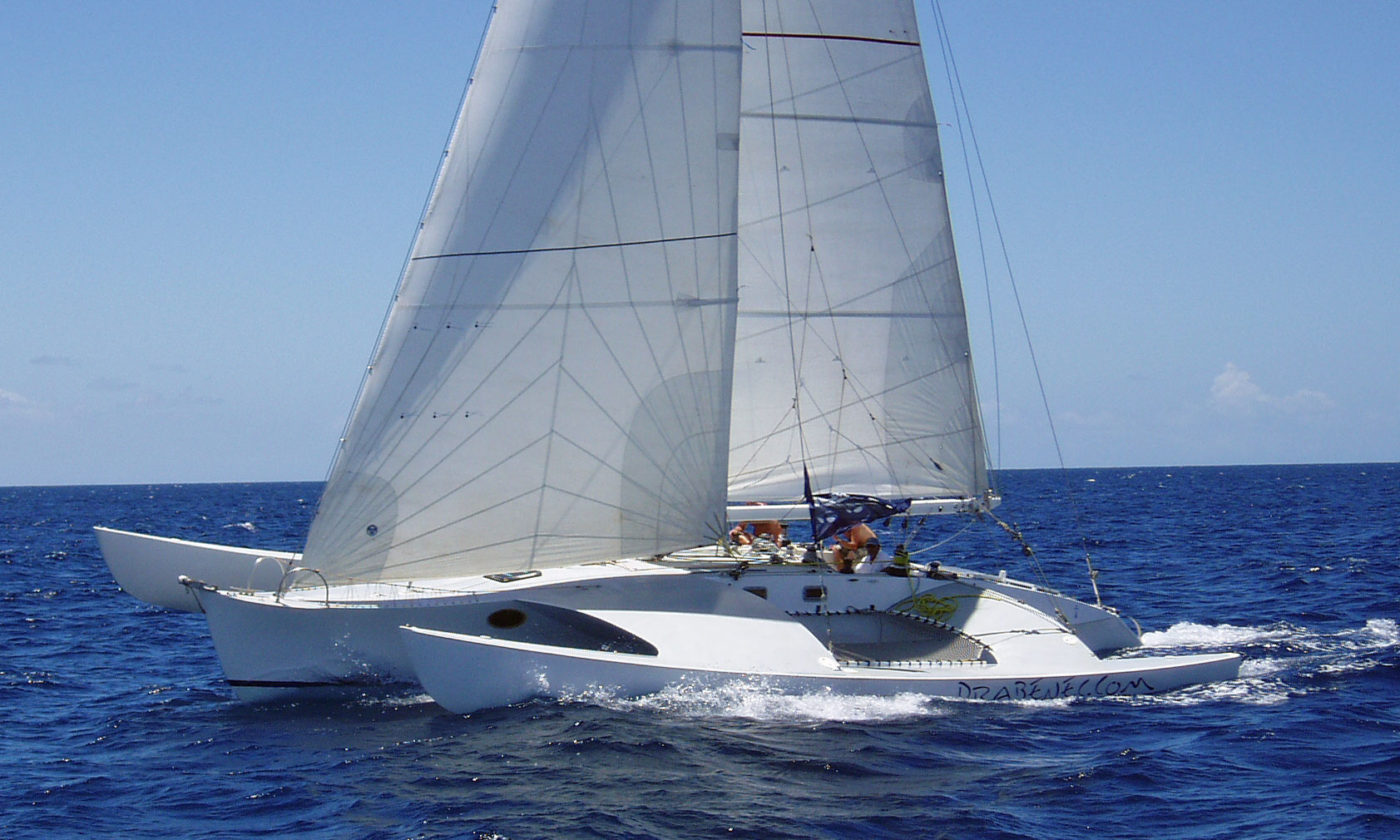 A Newick 45 Trimaran making good progress
A Newick 45 Trimaran making good progressTable of Contents
What are the Core Design & Performance Differences?
When you've spent years sailing a monohull, the world of multihulls can feel like "going to the dark side"—but it's a path I know well. With thousands of miles under my keel, I've seen firsthand how these two designs handle in everything from a stiff Solent chop to long offshore passages. It all comes down to their fundamental design principles.
A catamaran's design, with its twin hulls, is all about form stability. This translates to an incredibly level sailing platform, which is a blessing for both the cook in the galley and a crew member trying to get some rest off-watch. However, a crucial factor to consider is bridge deck clearance. In heavy seas, a catamaran with insufficient clearance can experience "slamming," where waves crash against the underside of the central deck, creating a jarring and loud motion that can be both uncomfortable and unsettling.
A trimaran, with its single central hull and two outrigger floats, is a different beast entirely. Its design is a masterclass in focused performance. The narrow main hull slices through waves with minimal drag, while the outriggers provide an exceptional righting moment, creating a vessel that is not only fast but also incredibly stiff and resistant to heeling. This design also offers a smoother motion in a seaway, reducing pitching and making it a more comfortable ride in rougher conditions compared to some catamarans.
 An Apache 41 Catamaran
An Apache 41 Catamaran| Attribute | Trimaran | Catamaran |
|---|---|---|
| Number of Hulls | Three (one main hull, two smaller floats) | Two (parallel hulls) |
| Primary Advantage | Speed & performance | Space & stability |
| Upwind Performance | Excellent, tracks well, less leeway | Good, but can be prone to more leeway |
| Downwind Performance | Very fast in the right conditions | Excellent, wide stance provides stability |
| Motoring & Maneuvering | Can be less agile in tight spaces (single engine) | Exceptional control with twin engines |
| Stability at Anchor | Can move a bit more | Rock-solid, very stable |
| Interior Volume | More compact, often within the main hull | Very spacious, large social areas & private cabins |
| Docking/Slip Costs | Can be very wide, leading to higher fees | Wider beam often results in double slip fees |
| Maintenance Costs | Typically a single engine, but more complex structure | Double engine maintenance, but simpler hull form |
How Do They Compare in Terms of Liveability & Cruising Comfort?
For most long-term cruisers, the boat is not just a mode of transport but a home. When you’re living aboard for months or even years, comfort and space become paramount.
This is where catamarans traditionally steal the show. Their dual-hull design provides a massive, open-plan bridgedeck salon that feels like a waterfront apartment. It offers fantastic separation of space, with private cabins often located in each hull—a perfect setup for a family or when hosting guests. The ample deck space is a huge bonus, allowing for easy outdoor living, entertaining, and storing gear.
Trimarans, on the other hand, prioritize sailing performance over sheer volume. Their more compact interiors are a direct result of their narrow, speed-focused hulls. While modern designs like the Neel Trimarans have made significant strides in creating more liveable spaces within the central hull, you will still have a smaller footprint than on a similarly sized catamaran. For sailors who believe less is more and value a dynamic sailing experience above all else, this trade-off is well worth it.
When it comes to mooring and docking, catamarans can be a joy to handle. The twin engines, spaced far apart, give you unparalleled control in tight marina spaces, allowing you to turn on a dime. Trimarans, with a single engine and their considerable beam, require more careful planning and skill when maneuvering. It’s a learning curve that all experienced sailors are equipped to handle, but it’s a factor to be aware of.
Safety, Seakeeping & Crew Considerations
In my experience, the unpredictable moods of the sea demand a vessel that is not only fast and comfortable but, above all, supremely safe. Both trimarans and catamarans offer significant safety advantages over monohulls, primarily through their inherent stability and unsinkable design.
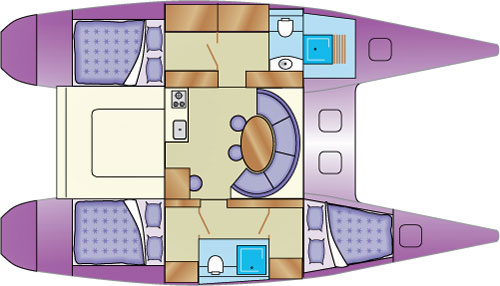 Commodious accommodation on this typical cruising catamaran...
Commodious accommodation on this typical cruising catamaran...Catamarans are known for their steady, flat ride. The wide stance makes capsizing extremely unlikely, although there is a small risk of "pitchpoling" (bows digging in and flipping end-over-end) in extreme conditions if not handled correctly. However, a properly sailed cruising catamaran is an incredibly safe platform.
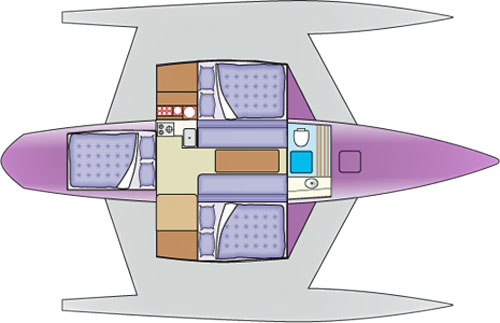 ...but rather less on this similarly sized trimaran.
...but rather less on this similarly sized trimaran.Trimarans also offer exceptional safety. As I’ve observed, the central hull combined with the stabilizing outriggers gives it an enormous righting moment that peaks at a much higher angle of heel than a catamaran, providing a larger margin for error in challenging conditions. Many modern trimarans are also built with buoyant foam cores, making them virtually unsinkable.
From a crew perspective, catamarans are generally considered easier to handle for a small crew or even a solo sailor, especially with their simple sail plans. Trimarans, with their performance focus, often have more active sail management and can demand a more attentive crew to get the most out of their design.
Operational Costs, Maintenance & Resale Value
The cost of ownership is a significant consideration for any sailor, and it extends well beyond the initial purchase price.
- Initial Cost & Resale Value: Catamarans have a high demand in the cruising market, which means they often command a premium price and hold their resale value well. Trimarans can sometimes offer better performance metrics at a slightly lower entry cost, and with their niche appeal, a well-maintained trimaran can also be an attractive proposition on the second-hand market.
- Marina & Mooring Fees: A major factor to consider is the beam. A catamaran's wide stance can mean double the slip fees at many marinas. This is a common pain point for catamaran owners. While a trimaran can be just as wide, some folding designs (such as those from Corsair Marine) can significantly reduce this issue by allowing the boat to be moored in a standard monohull slip.
- Maintenance: Both vessels have their own maintenance considerations. A catamaran has two engines, which means double the maintenance costs for oil changes, filters, and other engine-related work. A trimaran, typically with a single engine, has lower engine maintenance costs but may have a more complex structure to maintain.
- Haul-Outs: Hauling a multihull is more complex and often more expensive than a monohull due to their width. Finding a yard with a travel lift large enough to accommodate the wide beam of a multihull can be a challenge.
So, what’s the final verdict? Both trimarans and catamarans bring distinct strengths to the cruising scene, and your choice ultimately comes down to your sailing style and priorities.
If you crave speed, agility, and that heart-pounding thrill of high performance, a trimaran might be your perfect match.
On the other hand, if spacious living, ease of docking, and stability in choppy seas are your top priorities, then a catamaran could be the vessel for you.
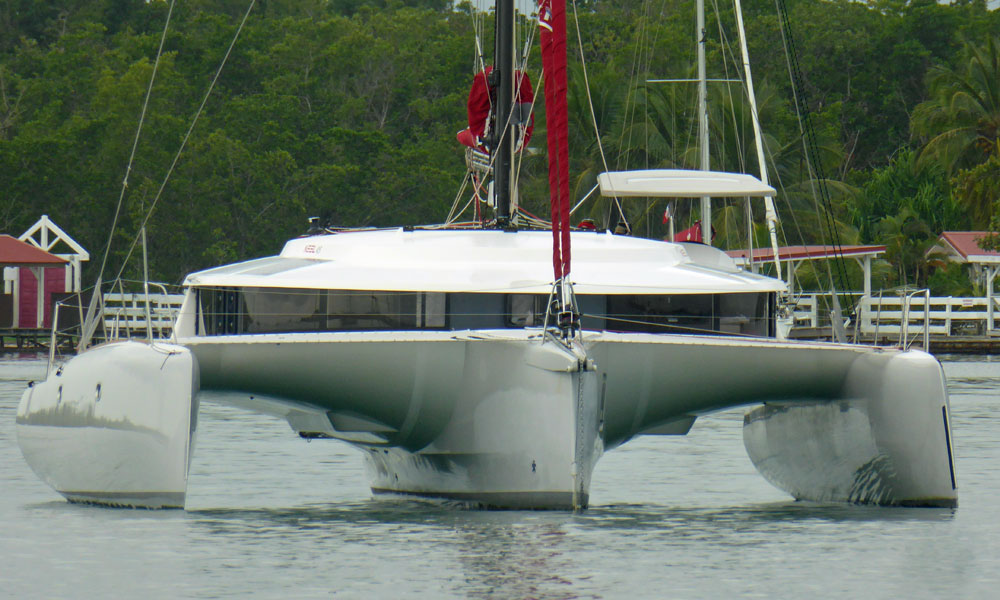 A Neel 45 maybe...
A Neel 45 maybe...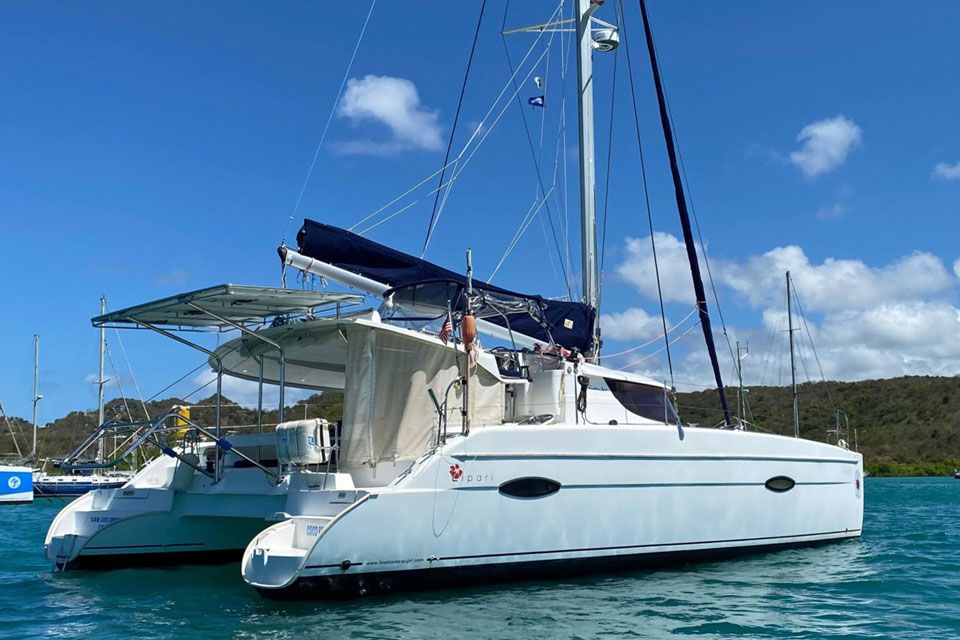 or perhaps a Fountain Pajot Lipari 41?
or perhaps a Fountain Pajot Lipari 41?Article by Dick McClary, RYA Yachtmaster Offshore and member of The Yachting Journalist Association (YJA)
FAQs About Cruising Catamarans & Trimarans
Are trimarans faster than catamarans?
Are trimarans faster than catamarans?
Generally, yes. Trimarans, especially performance-oriented models, are designed to be faster than cruising catamarans, particularly when sailing upwind. They have a greater speed potential across most points of sail
Which is better for living aboard?
Which is better for living aboard?
The consensus among cruisers is that a catamaran is superior for liveability due to its enormous interior volume, separation of living spaces, and expansive deck.
Can I single-hand a trimaran or catamaran?
Can I single-hand a trimaran or catamaran?
Yes, both can be single-handed, but the process is different. Catamarans, with their stable platforms and twin engines, can be easier to manage in marinas. Trimarans require a higher level of sailing skill but can be managed by an experienced single-hander.
What about seasickness on a multihull?
What about seasickness on a multihull?
Both designs are excellent for reducing seasickness compared to a monohull. The lack of heeling on a catamaran and the smooth, pitch-reducing motion of a trimaran are huge advantages for crew comfort.
Recent Articles
-
Planning Your Sailboat Liveaboard Lifestyle: An Ocean Sailor's Guide
Dec 06, 25 05:18 AM
Seasoned sailors share their methodical risk analysis for planning a secure Sailboat Liveaboard Lifestyle, covering financial, property, and relationship risks. -
Marine Cabin Heaters: The Expert’s Guide to Comfort & Safety at Sea
Dec 05, 25 06:52 AM
Choose the best Marine Cabin Heaters for your vessel. Expert advice on diesel, paraffin, and hot water systems for year-round cruising comfort. -
Marine Water Heating Systems: Free Hot Water from Your Boat's Engine
Dec 03, 25 05:06 PM
Tap into your engine's heat to get free hot water on board. An experienced ocean sailor's guide to marine water heating systems, calorifiers & safety.












